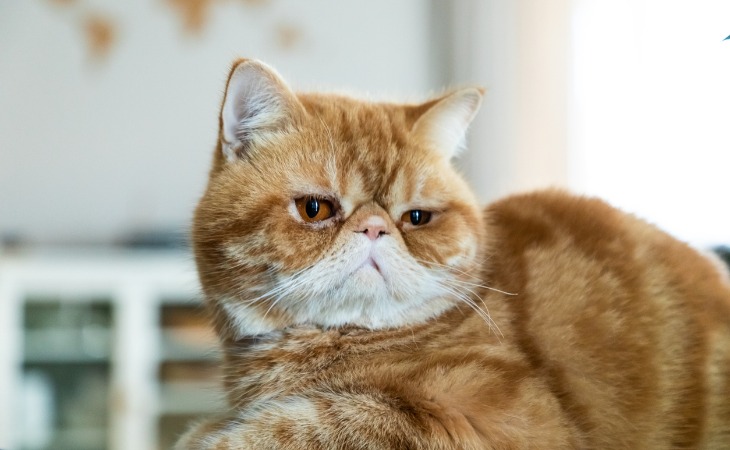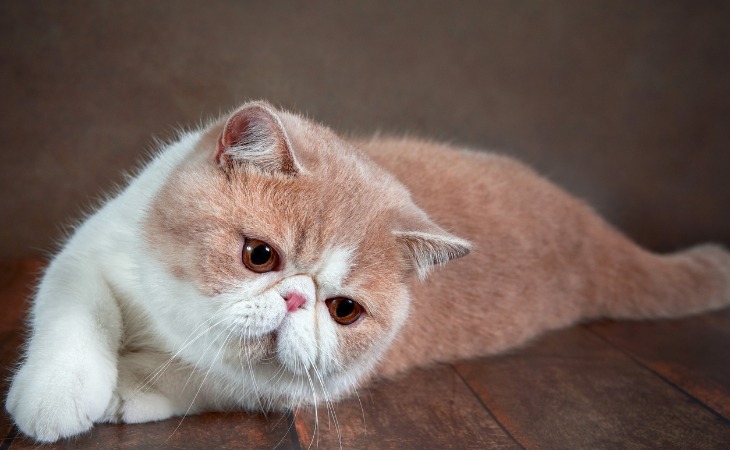Breed Standard: CFA, FIFe, TICA I Size: Medium to large I Average Lifespan: 13 to 16 years I Personality: Affectionate, calm, and playful I Coat: Short I Origin: United States.
Exotic Shorthairs and Persians have a lot in common. However, one of the things that differentiates the Exotic Shorthair from the Persian is its short coat.
The origins of the Exotic Shorthair
Where does the Exotic Shorthair come from?
This cat breed originated in the United States in the 1960s. Breeders were trying to improve the American Shorthair, which was very widespread in the United States at the time. They were trying to do this by crossing the American Shorthair with a green-eyed Persian. The goal was to create a breed with the physical characteristics of the Persian while keeping the short hair of the American Shorthair.
Developing the Exotic Shorthair
The kittens born from this cross were then carefully selected to purify the breed. Later, crosses were made with British Shorthairs, Russian Blues and Burmese cats to create new coat colors and to give the fur a fluffier look.
Today, the Exotic Shorthair breed is well-established. Crossbreeding is no longer tolerated, except with Persians.
The Exotic Shorthair’s notoreity
The Exotic Shorthair is a fairly new breed, recognized in 1967. Although it is very popular in North America, it is not as popular as its distant cousin, the Persian.
In cat shows, the Exotic Shorthair had a difficult time. Persian breeders feared that this cross would damage the reputation of their precious breed. Even nowadays, in Europe, some associations refuse to recognize the Exotic Shorthair as a breed in its own right, while in the United States the breed is very widespread.
The Exotic Shorthair’s personality
This breed is affectionate and adapts well to different situations. It is playful, slightly more active and lively than the Persian, but can live perfectly happy in an apartment.
The breed’s qualities
This sociable cat is a great playmate for children. They can spend time in the company of other cats and dogs without problems. It likes to walk around outside but does not stray too far from the house. The Exotic Shorthair is an endearing cat that loves to be close to humans and is a bit lazy. The breed meows very little, does not panic when there is noise, and is very patient. Compared to its cousin, the Persian, its coat requires much less maintenance.
The downsides of having an Exotic Shorthair
One of the main problems that this breed encounters is health problems. Because the breed has a flat face, it is prone to respiratory problems. In addition, because the Persian and the Exotic Shorthair have a lot in common, they present some of the same health issues. Some of these include breathing problems that can worsen with age and sometimes require surgery, cysts in the liver that can lead to kidney fragility and issues related to the sensitivity of their eyes. Some diseases, also inherited from the Persian, are genetic, like jaw deformation.
The physical characteristics of the Exotic Shorthair
General
Because this cat is so round, it looks a lot like a teddy bear. This medium to large cat breed has an impressive physique, meaning that it isn’t the most agile cat.
Head
Some of the breed’s main physical characteristic include its flat face and its large round eyes. The shape of its head is round and large with a large muzzle. Its eyes are very expressive and can be colors such as gold, green, copper, blue, and minnow. Its ears are small and spaced out. Ideally, the forehead, nose, and chin should be aligned vertically.
The body of the Exotic Shorthair
With a large body, round hips and shoulders, a broad chest, and a straight back, the Exotic Shorthair is quite muscular. It is a stocky cat with strong, short legs. The breed looks like it does not a neck because it is short and thick. Its tail is not very long but it is thick at the base with a rounded end.

Coat, color, and grooming
Coat
The Exotic Shorthair has short, dense hair. It has a thick undercoat that gives the breed’s fur a fluffy look. In addition, it is very soft to the touch.
Colors
Originally, the coat was silver, but other colors were introduced later. At present, all Persian coat colors are accepted for the Exotic Shorthair. These colors can be white, black, blue, red, cream, lilac, and chocolate. In addition, variations exist for females: tortoiseshell and blue cream.
Exotic Shorthairs can also be “tabby” like Persians: brown, blue, red, cream and silver-black. The coat can be spotted, marbled, or striped. Some Exotic Shorthairs are bicolored blue white, black white or cream white. When they are tricolored, red black white or cream blue white, it means that they are females.
Colorpoint cats have zones that are darker than others, similar to the Siamese.
Grooming
Thanks to its short hair, the Exotic Shorthair’s coat is easy to maintain. However, it is important to brush the coat once or twice a week. If necessary, you can brush it more. The goal is to limit shedding and to keep the coat looking nice and soft.
As this breed has sensitive eyes, they tend to leak. It is best to clean them each time they are wet with a special lotion that can be bought at a veterinary clinic.
It is important to vaccinate the Exotic Shorthair. Like for all cats, this protects against diseases such as typhus.
This cat is also prone to obesity because it loves to eat. It is best to keep an eye on their diet and to encourage it to exercise. It is important for the Exoic Shorthair to play since this feline like to lie down a good part of the day.
The Exotic Shorthair at a glance
Size: 30 to 35 cm (11.8 to 13.7 in).
Weight: Between 4 and 9 kg (8.8 and 19.8 lbs).
Health: This cat breed is prone to respiratory problems.
Average Lifespan: Between 13 and 16 years.
Is the Exotic Shorthair good for families with children? As this breed is playful, it is very great companion for children and does not get scared easily. It doesn’t show aggression, doesn’t mind being carried, and is very patient with children.

